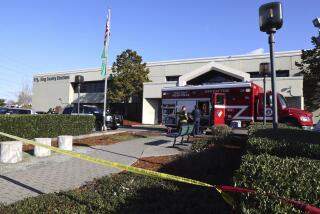Anthrax Tests Hint at Success
- Share via
WASHINGTON — The poisonous gas pumped into the Hart Senate Office Building last weekend appears to have killed any remaining anthrax spores, Environmental Protection Agency officials said Tuesday.
The agency must await lab tests to confirm the preliminary results, but monitoring equipment suggested that the fumigation worked on the second try. An earlier attempt failed when officials could not create the necessary levels of humidity.
“We feel very comfortable that we had a very successful fumigation,” said Richard Rupert, the EPA’s on-scene coordinator. “We feel that, based on the humidity numbers, the temperature and the concentration of chlorine dioxide, we were able to effectively destroy any anthrax spores.”
Technicians under the agency’s direction began pumping chlorine dioxide gas into the heating and ventilation system of the southeast quadrant of the building at 9 a.m. Friday. The process was completed at 4:30 a.m. Monday.
The quadrant had tested positive for anthrax spores after the earlier fumigation effort. The building, where half the 100 senators have their offices, closed Oct. 17, two days after an aide to Senate Majority Leader Tom Daschle (D-S.D.) opened an anthrax-tainted letter.
Daschle said Sunday that there is a reasonable possibility the building will reopen this month.
Officials are waiting for results, possibly later this week, on two types of laboratory tests.
One analysis is underway on more than 400 Band-Aid-size strips that will disclose the results of the fumigation. Separate tests are checking samples taken by swabbing and vacuuming surfaces.
The test strips contain bacteria more resistant to the gas fumigation than anthrax. If that bacteria is found dead, it will suggest that any remaining anthrax is too.
The surface samples are gathered by small vacuum cleaners with sock-like filters that are then analyzed, by swabbing surfaces with something similar to a Q-Tip and by wiping surfaces with a synthetic cloth the size of a handkerchief.
Rupert said more than 4,000 samples were taken from every room in the Hart building.
Meanwhile, with a Jan. 7 deadline for inoculations approaching, fewer than 100 people have opted to receive an anthrax vaccine out of thousands eligible, according to the Centers for Disease Control and Prevention.
Of the more than 3,000 people who have sought counseling to help decide if they need the extra therapy, more than 700 chose to take additional antibiotics.
More to Read
Sign up for Essential California
The most important California stories and recommendations in your inbox every morning.
You may occasionally receive promotional content from the Los Angeles Times.













